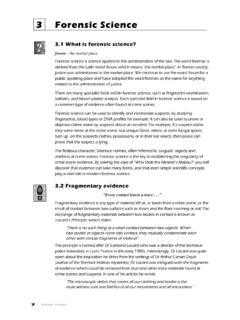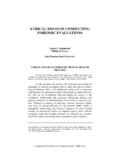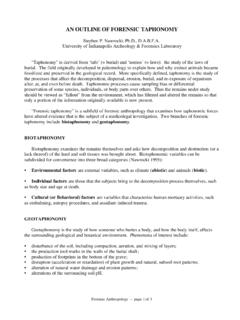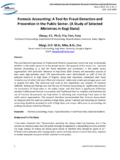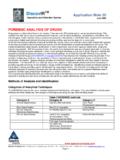Transcription of Protocols for Forensic Mitochondrial DNA Analysis …
1 Controlled versions of Department of Forensic Biology Documents only exist electronically on the Forensic Biology network. All printed versions are non-controlled copies. Forensic BIOLOGY Protocols FOR Forensic Mitochondrial DNA Analysis Primary Approving Authority: Mark A. Desire, Technical Leader Mitochondrial DNA Operations Working version as of 04/15/2016 Table of Contents Mitochondrial DNA Guidelines .. 4 A. General Procedures: .. 4 B. Nomenclature .. 5 C. Repeat Analysis of Samples .. 6 D. Batching and Duplication Guidelines .. 7 Hair Evidence Examination .. 9 A. Hair Evidence Examination .. 9 B. Mideo Macro/microscopic digital imaging system .. 10 C. Printing digital and mideo images for case file .. 12 Washing Hair for Mitochondrial or Nuclear DNA Testing ..13 A. Demounting .. 13 B. Washing the hair for mtDNA testing extraction .. 13 C. Washing the hair for nuclear DNA testing extraction .. 14 Organic Extraction for Mitochondrial or Nuclear DNA Testing.
2 16 A. Extraction for Mitochondrial and Nuclear DNA testing .. 16 B. Purification of DNA for Mitochondrial and Nuclear DNA testing .. 17 NYC OFFICE OF CHIEF MEDICAL EXAMINER NYC OFFICE OF CHIEF MEDICAL EXAMINERC ontrolled versions of Department of Forensic Biology Documents only exist electronically on the Forensic Biology network. All printed versions are non-controlled copies. Duplex Mitochondrial DNA PCR Amplification ..19 A. Preparing the DNA aliquots for HVI-HVII amplification .. 19 B. Amplification Setup .. 20 C. Thermal Cycling .. 22 Quantitation using Agilent 2100 Bioanalyzer ..25 A. Preparing the documentation:.. 25 B. Preparing the 25 C. Procedure .. 25 Section A- Preparing the gel-dye mix .. 26 Section B- Loading and running of the Agilent Bioanalyzer 2100 .. 26 Section C- Data collection, Analysis , electronic filing .. 29 Section D- Data Entry, Review, Filing, Rerun .. 30 REVIEW .. 33 RERUNS .. 33 EXO-SAP-IT Sample Cleanup.
3 34 Cycle-Sequencing ..36 SDS Cleanup ..39 Centri-Sep Sample Filtration ..40 A. Procedure for Single Columns .. 40 B. Procedure for Centri-Sep 8 Strips .. 41 ABI 3130xl Sequencing ..42 A. Setting up a 3130xl Run .. 42 B. Creating a Plate ID .. 45 C. Preparing the DNA Samples for Sequencing .. 46 D. Placing the Plate onto the Autosampler (Linking and Unlinking Plate) .. 47 E. Viewing Run Schedule and Starting Run .. 48 F. Water Wash and POP Change .. 50 3130xl Genetic Analyzer Troubleshooting .. 51 Instrument Startup .. 51 Spatial Calibration .. 53 Spectral Calibration .. 54 Run Performance .. 55 Mitochondrial DNA Sequencing Analysis ..62 A. Transfer of the 3130xl run data into the master file .. 62 B. Sequence 63 C. Sequencher .. 65 D. File Output and Construction .. 71 E. Data Review .. 71 F. Archiving the Sequencher Data .. 72 Sequence Nomenclature and Alignment ..75 A. Using Sequencher .. 75 B. Using Sequencher .. 77 Editing Guidelines.
4 80 NYC OFFICE OF CHIEF MEDICAL EXAMINER NYC OFFICE OF CHIEF MEDICAL EXAMINERC ontrolled versions of Department of Forensic Biology Documents only exist electronically on the Forensic Biology network. All printed versions are non-controlled copies. Interpretation Guidelines ..81 GUIDELINES FOR CONTROLS .. 81 A. Negative controls .. 81 B. Positive controls .. 85 Guidelines for 86 A. Sequencing: Reporting of Base Calls .. 86 B. Criteria for Mixture Recognition .. 87 C. Sequence Comparisons .. 88 Statistical Analysis ..90 Creation of a Casefile CD ..94 References ..95 Appendix A Oglionucleotide Primer Sequences ..98 Appendix B Mitochondrial DNA Primer Locations ..100 Appendix C- Revised Cambridge Reference Sequence ..102 NYC OFFICE OF CHIEF MEDICAL EXAMINER NYC OFFICE OF CHIEF MEDICAL EXAMINERPROTOCOLS FOR Forensic Mitochondrial DNA Analysis Mitochondrial DNA GUIDELINES DATE EFFECTIVE 04-01-2014 APPROVED BY Mitochondrial DNA TECHNICAL LEADER PAGE 4 OF 103 Controlled versions of Department of Forensic Biology Documents only exist electronically on the Forensic Biology network.
5 All printed versions are non-controlled copies. Mitochondrial DNA Guidelines PURPOSE: Guidelines for Mitochondrial DNA testing to ensure clean laboratory practices, unambiguous sample identification, and relevant control runs. A. General Procedures: To reduce the possible contamination in the laboratory that could occur: (i) between the analyst and the samples (ii) from one sample to another, or (iii) from extraneous sources of DNA within the laboratory. 1. Lab coat, gloves, and mask, eye protection, and/or face shield, must always be worn while in the exam and pre-amplification room. Lab coat, gloves, eye protection must be worn in the post amplification area. All gowning must be done in the vestibules of exam, pre-amp or post amp rooms. 2. Lab coats can be reused for a period of one week. Afterwards, they should be thrown out. Masks/face shields can also be reused for a period of one week.
6 Goggles can be exposed to UV light in the Stratalinker to extend their time of use. 3. When working in the exam or pre-amplification laboratory, gloves must be rinsed in 10% bleach before each procedure and in-between the handling of separate samples. 4. Pipettes must be wiped down with 10% bleach before each procedure, and between the pipetting of separate samples. 5. All hoods must be wiped down with 10% bleach before and after each procedure, followed by a 70% Ethyl Alcohol rinse, and UV light, if available, should be applied for 30 minutes before and following each procedure. 6. All racks, tube-openers and any other plastic implements (but not the pipettes) must be exposed to UV light in the Stratalinker for a minimum of 30 minutes before they can be used for amplification or extraction. 7 Any 96-well tube racks taken from the pre-amp room to the post-amp room must be placed into the post-amp bleach bath, rinsed, and dried prior to being returned to the pre-amp room.
7 8. All and tubes can be kept in plastic Nalgene boxes or comparable containers, and should only be removed with bleached and dried gloves while fully gowned. Prior to placement of tubes into these containers, the tubes used for, washing, extraction and amplification must be exposed to UV light in the Stratalinker for 30 minutes. NYC OFFICE OF CHIEF MEDICAL EXAMINER NYC OFFICE OF CHIEF MEDICAL EXAMINERPROTOCOLS FOR Forensic Mitochondrial DNA Analysis Mitochondrial DNA GUIDELINES DATE EFFECTIVE 04-01-2014 APPROVED BY Mitochondrial DNA TECHNICAL LEADER PAGE 5 OF 103 Controlled versions of Department of Forensic Biology Documents only exist electronically on the Forensic Biology network. All printed versions are non-controlled copies. 9. Counters, sinks, refrigerator/freezer handles and door handles inside the laboratory and gowning room should be wiped down with 10% bleach on a monthly basis.
8 B. Nomenclature The following are suggested naming conventions for use throughout the sample processing. The goal of this nomenclature is to ensure that sample names are unique identifiers. 1. Samples re-extracted for the purposes of duplication (new cutting): The suffix : dup will be added to the sample name to separately identify the re-extraction sample from the original, and this suffix will be applied to these duplication samples throughout the processing 2. Samples reamplified in order to improve on the quality of the results or for other purposes: The suffix reamp will be added to the sample name. If multiple reamplifications are necessary, the numeral 1, 2, 3, etc. will be added to the suffix. 3. At the 3130xl run step: - The suffix recyc will be added to each sample name for samples that are re- sequenced ( sample-recyc). If multiple re-cycle sequences are necessary, the numeral 1, 2, 3, etc.
9 Will be added to the suffix. - The suffix conf will be added to each sample name for samples that are re- sequenced to confirm sequence or length heteroplasmy ( sample-conf). If multiple confirmatory sequences are necessary, the numeral 1, 2, 3, etc. will be added to the suffix. - The suffix reinj will be added to each sample name for samples that are re- injected ( sample-reinj). If multiple reinjections are necessary, the numeral 1, 2, 3, etc. will be added to the suffix. - The primer used will be added as suffix to each sample name. This suffix will always be added last, sample-B4, sample-recyc-1-B4, sample-conf-2-B4, sample-reinj-3-B4. 4. Contig name: - A contig name should be: FBYY-12345-HVI, or FBYY-12345-HVII, or FBYY-12345-HVI dup, FBYY-12345-HVII dup NYC OFFICE OF CHIEF MEDICAL EXAMINER NYC OFFICE OF CHIEF MEDICAL EXAMINERPROTOCOLS FOR Forensic Mitochondrial DNA Analysis Mitochondrial DNA GUIDELINES DATE EFFECTIVE 04-01-2014 APPROVED BY Mitochondrial DNA TECHNICAL LEADER PAGE 6 OF 103 Controlled versions of Department of Forensic Biology Documents only exist electronically on the Forensic Biology network.
10 All printed versions are non-controlled copies. - In certain cases more than one sample will be typed and identifiers could be added after FBYY-12345, FBYY-12345(V)-HVI, FBYY-12345-PM7-HVI, FBYY-12345-PM1-HVI, FBYY-12345-Q1-HVI, FBYY-12345-Q2-HVI 5. Sequencher ID - The sequencher ID of an analyzed run will be identical to that run ID, SYY-123. - The sequencher ID of a case will be identical to the FB case number, FBYY-12345. - The sequencher ID for a Missing person case will be the FB# space MP ( FBYY-12345 MP) C. Repeat Analysis of Samples Repeat testing of a sample can start at different stages, as listed below. Appropriate controls must be used. 1. Extraction stage: A new extraction negative control must be run. 2. Amplification stage: New amplification negative and positive control must be included. The extraction negative control does not need to be repeated if it previously passed.










